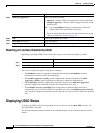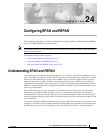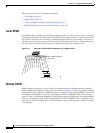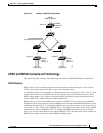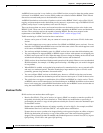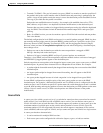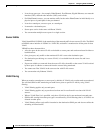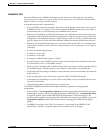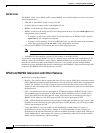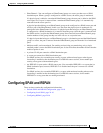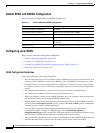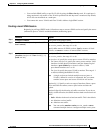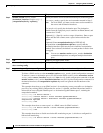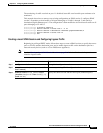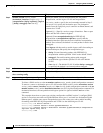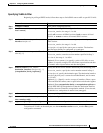
24-8
Cisco ME 3400 Ethernet Access Switch Software Configuration Guide
78-17058-01
Chapter 24 Configuring SPAN and RSPAN
Understanding SPAN and RSPAN
RSPAN VLAN
The RSPAN VLAN carries SPAN traffic between RSPAN source and destination sessions. It has these
special characteristics:
• All traffic in the RSPAN VLAN is always flooded.
• No MAC address learning occurs on the RSPAN VLAN.
• RSPAN VLAN traffic only flows on trunk ports.
• RSPAN VLANs must be configured in VLAN configuration mode by using the remote-span VLAN
configuration mode command.
–
To change a VLAN from a UNI isolated VLAN (the default) to an RSPAN VLAN, enter the
rspan-vlan VLAN configuration command.
–
To change a UNI community VLAN to an RSPAN VLAN, you must first remove the community
VLAN type by entering the no uni-vlan VLAN configuration command.
• STP can run on RSPAN VLAN trunks but not on SPAN destination ports.
Note Only NNIs support STP; UNIs do not support STP.
• An RSPAN VLAN cannot be a private-VLAN primary or secondary VLAN.
It is normal to have multiple RSPAN VLANs in a network at the same time with each RSPAN VLAN
defining a network-wide RSPAN session. That is, multiple RSPAN source sessions anywhere in the
network can contribute packets to the RSPAN session. It is also possible to have multiple RSPAN
destination sessions throughout the network, monitoring the same RSPAN VLAN and presenting traffic
to the user. The RSPAN VLAN ID separates the sessions.
SPAN and RSPAN Interaction with Other Features
SPAN interacts with these features:
• Routing—For switches that are running the metro IP access image, SPAN does not monitor routed
traffic. RSPAN only monitors traffic that enters or exits the switch, not traffic that is routed between
VLANs. For example, if a VLAN is being receive-monitored and the switch routes traffic from
another VLAN to the monitored VLAN, that traffic is not monitored and is not received on the SPAN
destination port.
• STP—A destination port does not participate in STP while its SPAN or RSPAN session is active.
The destination port can participate in STP after the SPAN or RSPAN session is disabled. On a
source port, SPAN does not affect the STP status. STP can be active on trunk ports carrying an
RSPAN VLAN. However, only NNIs support STP; UNIs do not participate in STP.
• CDP—A SPAN destination port does not participate in CDP while the SPAN session is active. After
the SPAN session is disabled, the port again participates in CDP. However, only NNIs support CDP;
UNIs do not participate in CDP.
• VLAN and trunking—You can modify VLAN membership or trunk settings for source or
destination ports at any time. However, changes in VLAN membership or trunk settings for a
destination port do not take effect until you remove the SPAN destination configuration. Changes in
VLAN membership or trunk settings for a source port immediately take effect, and the respective
SPAN sessions automatically adjust accordingly.



